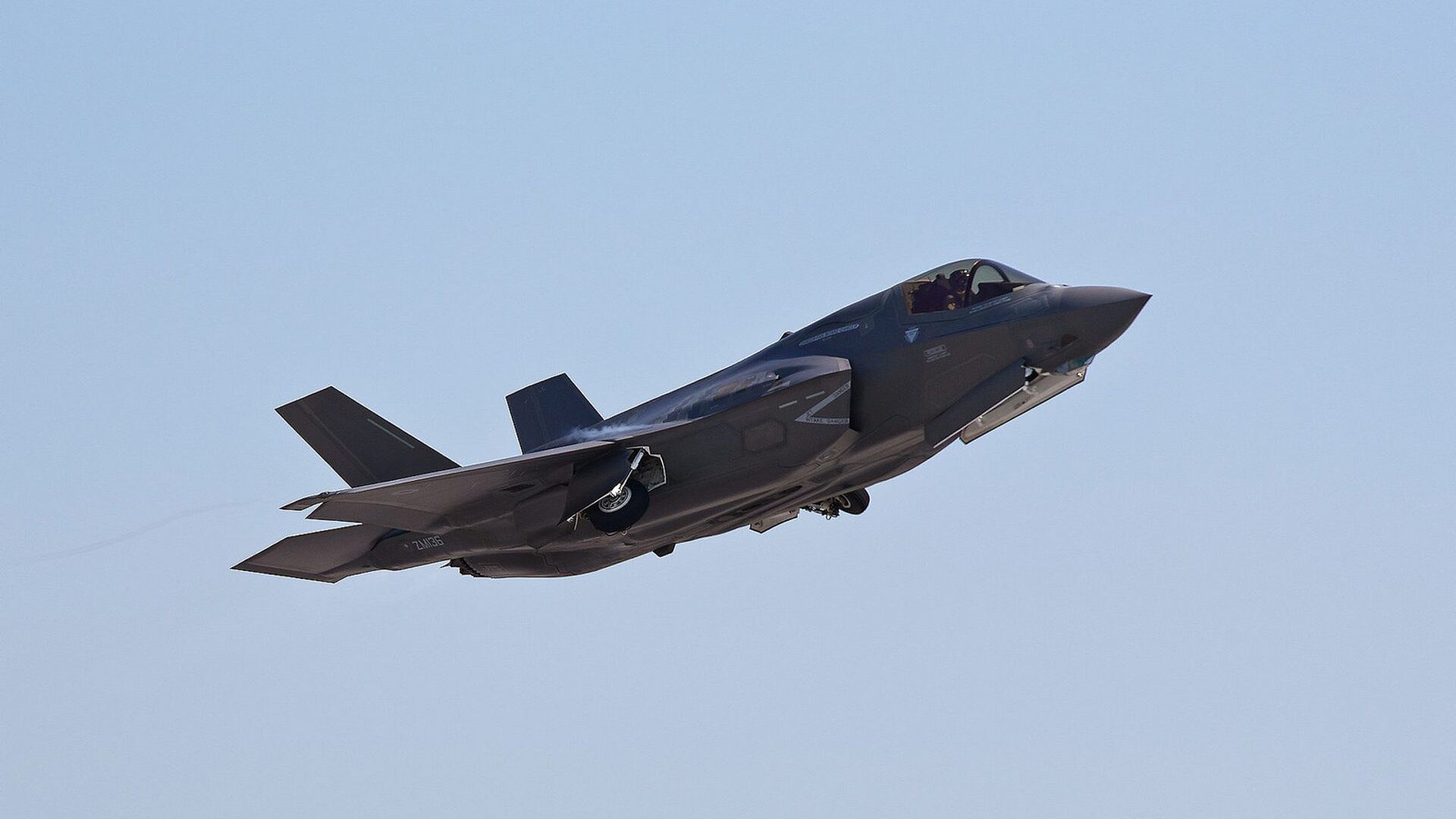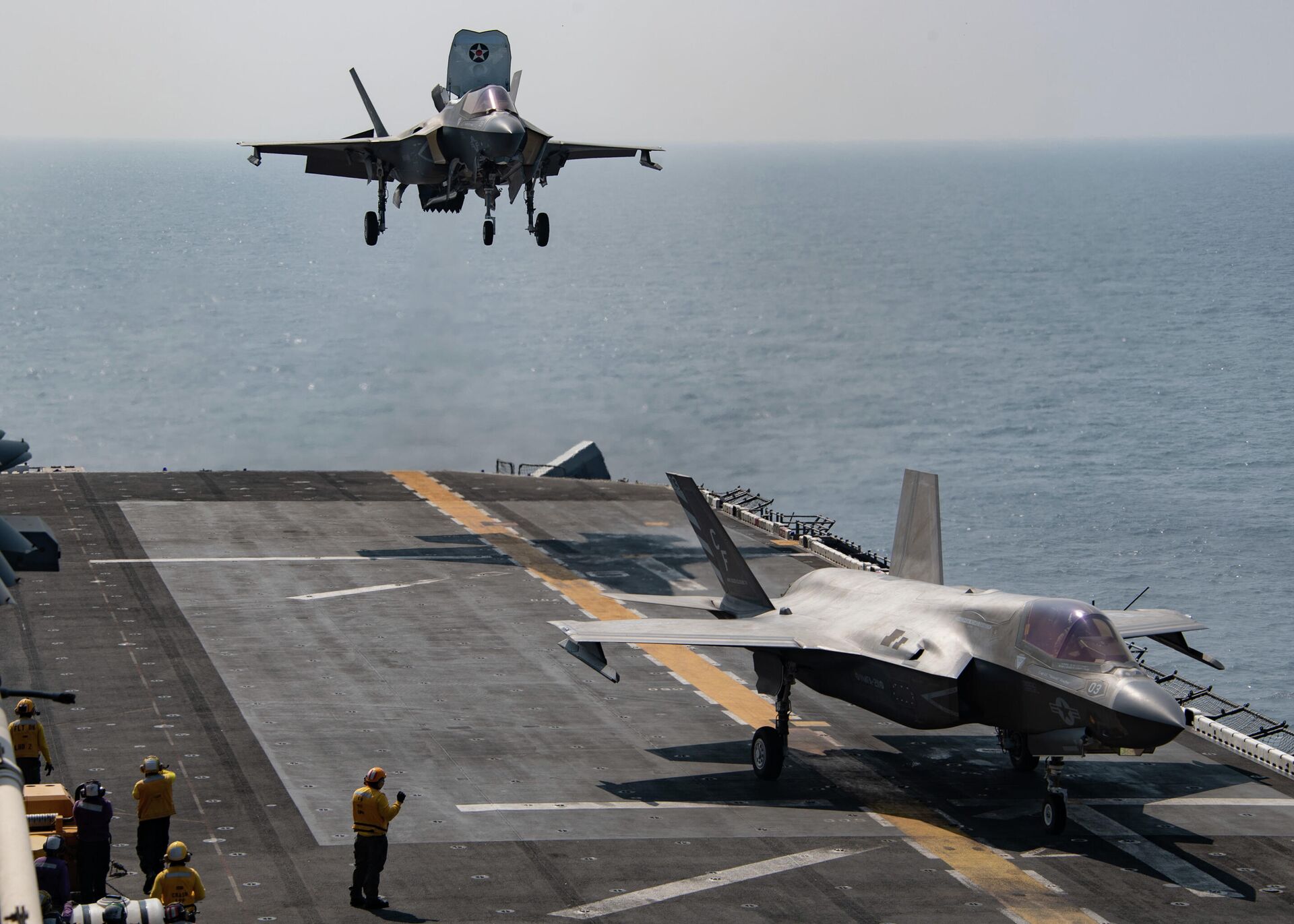UK Experts 'Know’ Location of Crashed F-35 Jet As Security Aspects Prompt 'Cautious' Recovery
10:41 GMT 01.12.2021 (Updated: 15:17 GMT 28.05.2023)

© Flickr / Defence Images
Subscribe
After a video surfaced on social media apparently showing an F-35 fighter jet of the Royal Air Force from the UK flagship HMS Queen Elizabeth crashing into the Mediterranean during a routine operation, with the pilot ejecting; the British Ministry of Defence issued a statement confirming an investigation into the incident.
A UK Royal Airforce F-35 fighter jet seen crashing into the Mediterranean Sea on 17 November has been found in a leaked video, reported the Daily Mail.
“My understanding is that the experts know where the aircraft is,” National Security Adviser Sir Stephen Lovegrove was cited as saying on Tuesday.
The aircraft, one of the eight F-35s and 10 US Marine Corps F-35s currently aboard the HMS Queen Elizabeth aircraft carrier, fell over the edge into the water instead of gaining speed, with the pilot ejecting.
Well thank God he is still with us! That’s all I can say. pic.twitter.com/YtL6f0BFAm
— Seb H (@sebh1981) November 29, 2021
A leaked, 16-second clip of the incident, taken possibly from a surveillance camera, was copied using a smartphone and posted on Twitter, according to the outlet, with a probe likely to be opened into how it became public.
A statement by the UK Ministry of Defence Press Office, stated that the pilot, who sustained minor injuries, had been rescued and returned to the ship following a successful ejection.
A British F35 pilot from HMS Queen Elizabeth ejected during routine flying operations in the Mediterranean this morning.
— Ministry of Defence Press Office (@DefenceHQPress) November 17, 2021
The pilot has been safely returned to the ship and an investigation has begun, so it would be inappropriate to comment further at this time.
Sir Stephen Lovegrove was cited as saying in the UK House of Commons Defence Committee that it was “premature” to comment on the reasons for the accident. Earlier reports suggested that one cause of the crash could have been a rain cover left on the plane, which was then sucked into the jet’s engine. Another report, cited by the Daily Mail, reported that a plug in the engine during takeoff might have triggered the incident.
“The recovery of the flight data recorder and the wreckage are really vital for an accurate investigation to determine the causes of the crash. Clearly the swift recovery of the aircraft is what we would like to do and we are working closely with allies on the mechanics of that. We haven't got the plane up yet,” the UK National Security Adviser was quoted as saying.
The US-designed plane contained sensitive technology onboard such as top-secret radar and sensors, allowing it to fly “unseen” in a hostile environment supersonic speeds. This has sparked concerns that Britain’s rivals or potential adversaries might be searching for it. The underwater race to find the wreckage of the jet was reportedly carried out clandestinely jointly with the US, using divers, miniature submarines and inflatable bags.
“We are aware of Russian undersea capabilities, and you are quite right to identify them as being state of the art. The kinds of precautions and operations that we are undertaking at the moment are designed at least in part to ensure that the technology of the F-35 remains as confidential as you would like it to be. Those security aspects are very much at the top of our mind,” added Lovegrove.
The F-35B is believed to be the first such jet lost by Britain, raising concerns about the quality of the cutting-edge warplane, which boasts stealth and intelligence-gathering capabilities. Britain currently has 24 such planes and is on track to buy 138 more for £9.1 billion from America’s Lockheed Martin.

F-35B Lightning II attached to Marine Fighter Attack Squadron (VMFA) 211, deployed with the British Royal Navy aircraft carrier HMS Queen Elizabeth, lands on the flight deck of the amphibious assault ship USS Essex (LHD 2) during an interoperability exercise with Queen Elizabeth, Nov. 8. Essex and the 11th Marine Expeditionary Unit are deployed to the U.S. 5th Fleet area of operations in support of naval operations to ensure maritime stability and security in the Central Region, connecting the Mediterranean and the Pacific through the western Indian Ocean and three strategic choke points.
© Petty Officer 2nd Class Wesley R
In line with a deal, 48 of the jets are anticipated to be delivered by 2025. At a recent session of the Defence Committee, Jeremy Quin, Minister for Defence Procurement, was cited as saying:
“We have committed to have 48 in service by 2025, and we will be acquiring more. We have set that out in the IR. We will set out the exact numbers in 2025. The 138 number is still there. That is a defined number and we are looking at keeping these aircraft carriers in operation for a very long period of time.”
The 65,000-tonne flagship aircraft carrier Queen Elizabeth, which entered the British Navy in 2017, is carrying on deck eight F-35B Lightning II-fast jets, four Wildcat maritime attack helicopters, seven Merlin Mk2 anti-submarine and airborne early warning helicopters, and three Merlin Mk4 commando helicopters.

This handout image provided by the official Twitter account of Commodore Steve Moorhouse, Royal Navy, Commander of the UK Carrier Strike Group on July 6, 2021 shows a view of the vessels of the strike group sailing behind the Royal Navy's HMS Queen Elizabeth aircraft carrier through Egypt's Suez Canal.
© AFP 2023 / ROYAL NAVY / CROWN COPYRIGHT
The largest warship in the history of the Royal Navy is currently returning from a maiden trip around the world that began on May 22.


